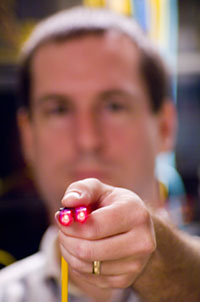Newport News, Va. – Scientists who conduct research at the Department of Energy’s (DOE’s) Thomas Jefferson National Accelerator Facility can now access and share research data faster than ever before, thanks to an upgraded Internet connection that provides data transfer rates of up to 10 Gigabits per second (Gbps). The upgrade connects Jefferson Lab directly to other local universities and laboratories as part of the Eastern Litewave Internetworking Technology Enterprise (E-LITE) partnership.
The upgrade allows researchers to transfer large data files up to 60 times faster than before. Transferring one TeraByte of data now takes just 15 minutes, compared to 15 hours at Jefferson Lab’s previous peak data transfer rate of 155 Megabits per second (Mbps). One Terabyte of data is the equivalent of a nine-mile-high stack of standard sheets of paper printed on both sides.
"Jefferson Lab experimenters need to share the raw data from experiments, reconstructed data, analysis data, and simulation data. This is in addition to the normal business information that you’d want to share over the Internet," says Andy Kowalski, Deputy Computer Center Director and coordinator of the network upgrade.
As an example, consider a typical research data file gathered at Jefferson Lab. Before the upgrade, one group of experimenters needed to transfer 11 TeraBytes of data to a collaborating university. At best, a direct transfer of the data would have taken 165 hours (almost seven days); that same transfer can now be completed in just 2.5 hours.
An intricate system of agreements and partnerships with local, regional and national research institutions and high-speed network providers made the upgrade possible (see Key Terms). The upgrade was recently completed with the final installation and testing of fiber-optic cabling between Jefferson Lab, Old Dominion University (ODU), and a node in McLean, Va. The cabling is part of a regional fiber-optic network built by Verizon. With the new connection fully established Sept. 1, system testing began Sept. 7, followed by the connection becoming fully operational Sept. 20.
"This is a great achievement for Jefferson Lab. It provides researchers with a new capability in terms of more easily sharing data and data analysis," says Roy Whitney, Jefferson Lab’s Chief Information Officer. "We are now able to transmit vast amounts of data at an incredibly accelerated rate, which further enhances our world-class research capabilities. This achievement came from a great collaboration with local universities and research centers via E-LITE, the DOE’s Energy Sciences Network; the Virginia universities that have put together VORTEX and MATP with its access to the National LambdaRail; and the help of SURA – one of the partners in the management of Jefferson Lab." (see Key Terms)
"This upgrade also supports the future bandwidth requirements of the experimental program, the Lattice QCD computing, the planned 12 GeV Upgrade and a number of other projects here at Jefferson Lab," Kowalski says. The 12 GeV Upgrade project will double the energy of the electron beam and upgrade the scientific capability of four experimental halls to allow JLab scientists to delve even deeper into the mysteries of matter.
In addition to Jefferson Lab, the E-LITE network sponsored by ODU also connects ODU’s Virginia Modeling, Analysis and Simulation Center (VMASC); The College of William and Mary; NASA’s Langley Research Center and the U.S. Joint Forces Command (JFCOM) together and with other organizations across Virginia and the country.
Contacts:
Kandice Carter
carter@jlab.org
757-269-7263
Debbie Magaldi
magaldi@jlab.org
757-269-5102
Key Terms
Gbps – One Gigabit per second is a unit of data transfer rate equal to 1,000,000,000 bits per second.
E-LITE – The Eastern Litewave Internetworking Technology Enterprise is a partnership among several Hampton Roads research centers lead by Old Dominion University (ODU) and including Jefferson Lab, The College of William & Mary, ODU’s Virginia Modeling, Analysis and Simulation Center, NASA’s Langley Research Center, and the U.S. Joint Forces Command.
VORTEX – The Virginia Optical Research Technology Exchange is a statewide fiber-optic network that provides connections to MATP. Old Dominion University sponsors the VORTEX point of presence (POP), or connection, in Norfolk, Va.
MATP – The Mid-Atlantic Terascale Partnership (MATP) is a consortium of research institutions in Virginia, Maryland and Washington, D.C. The consortium was formed to support a National LambdaRail node in McLean,Va. This facility also provides Jefferson Lab access to Internet2 and ESnet.
SURA – The Southeastern Universities Research Association paid Jefferson Lab's membership fee to MATP. SURA partnered with Computer Sciences Corporation Applied Technologies Division, LLC, to form Jefferson Science Associates, LLC, the corporation that manages and operates Jefferson Lab under contract to DOE.
NLR – The National LambdaRail is a dedicated, advanced network connecting universities, national research centers and laboratories. It fosters advanced network applications and provides the resources demanded by cutting-edge network research.
ESnet – The Energy Sciences Network (ESnet) is a high-speed network serving thousands of Department of Energy scientists and collaborators worldwide. It is funded principally by DOE's Office of Science and is managed and operated by ESnet staff at Lawrence Berkeley National Laboratory.
Verizon – Verizon provides and maintains the 10 Gbps, high-speed network that connects E-LITE partners in Hampton Roads.


